October 31, 2019
 by Mike Glover / October 31, 2019
by Mike Glover / October 31, 2019
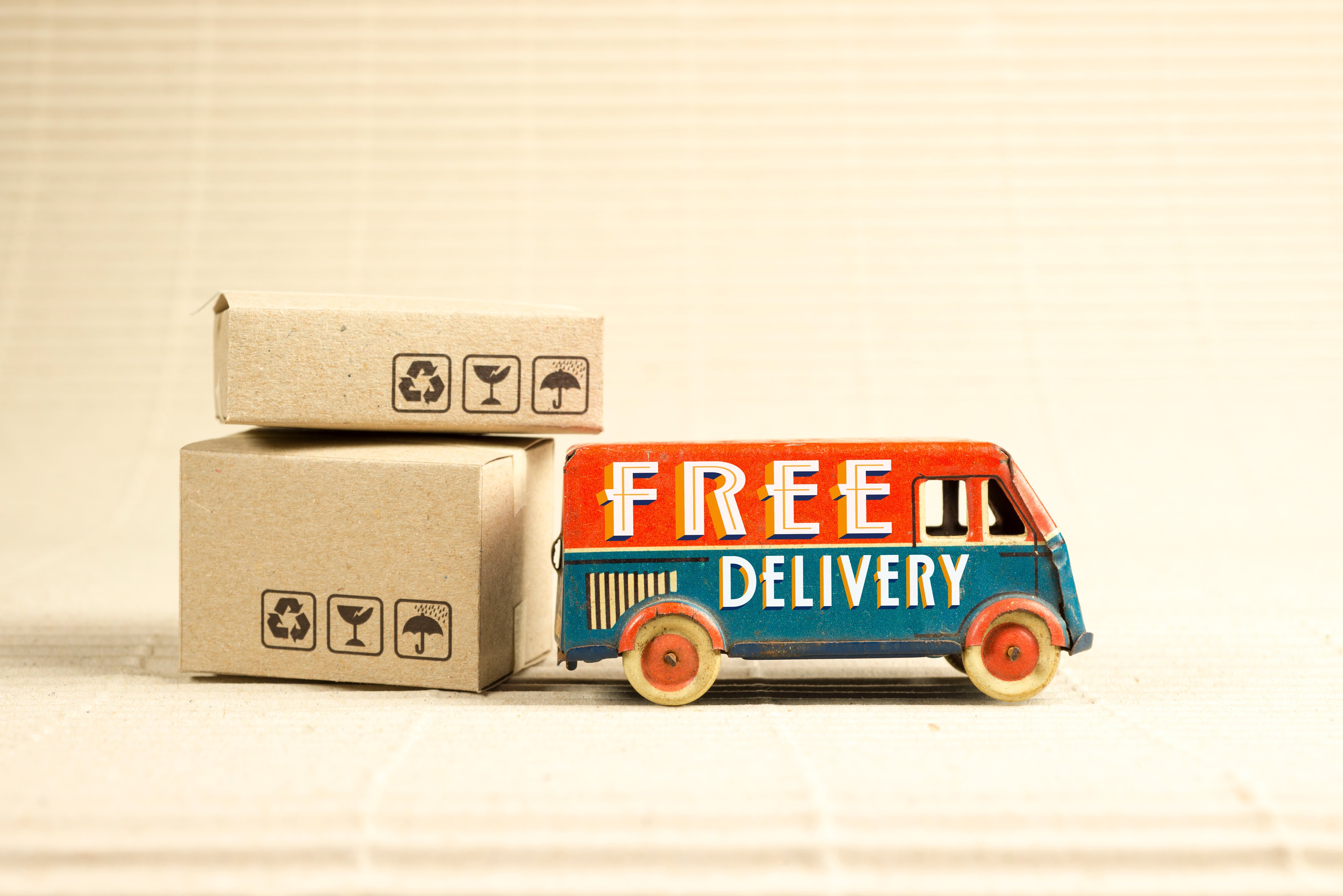
Free shipping is a powerful weapon in e-commerce. Helping remove another layer of friction in the consumer buying process.
But offering it can also have a big impact on profits. In this article, we go into free shipping strategy. Covering everything you need to think about when it comes to offering competitive free shipping – without tanking your profits.
Free shipping is extremely popular amongst online shoppers. And for many it’s no longer a “nice to have,” but a downright expectation, thanks to corporations like Amazon and others.
A quick google search will confirm that:
|
So the benefit of offering free shipping is massive. But is there a profitable way to offer it to customers?
The answer is that there’s no one-size-fits-all solution when it comes to free shipping. What works for one business will destroy another. Let’s look at some different ways to offer free shipping, and how to ensure it’s profitable for your business.
Shoppers will go to great lengths to avoid paying for shipping, and will often add extra items to their cart to achieve this. Giving customers an option to qualify for free shipping will often encourage them to choose the free method, even if it means paying more for their order overall.
It’s a great way to increase average order value. Plus, customers really value this “freebie,” even if the end cost to them is actually more. There are many different options for providing customers with this choice.
One option to offer “free” shipping is to charge customers a membership fee to receive free shipping all year, charging annually or monthly. A great example is Amazon Prime.
For $12.99/month, customers become Prime members to receive free one-day shipping on eligible orders, along with added benefits like the prime video streaming service and free reading on eligible kindle books.
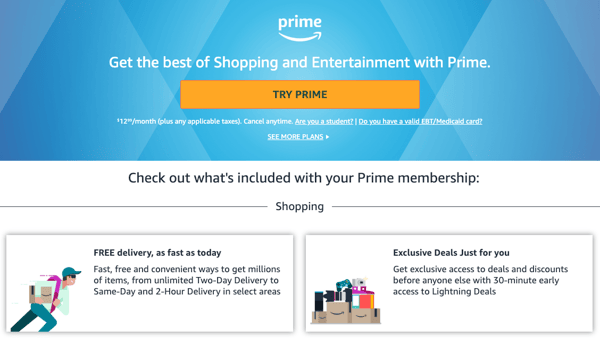
A slightly smaller scale example would be that of fashion retailer ASOS. They offer a Premier Delivery service that includes unlimited two-day shipping on all orders for $19 a year.
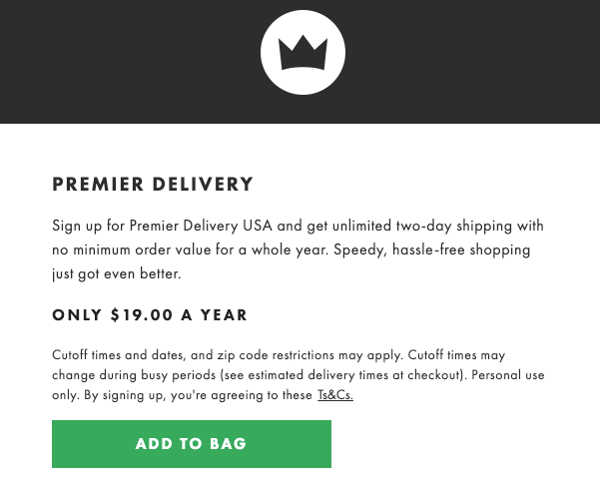
This allows ASOS to segment their most loyal customers. Then market to them specifically with bespoke offers and sales throughout the year. This free shipping option may not cover shipping costs for each customer as a whole. But can significantly increase your turnover as customers will choose to make you their supplier of choice.
It works nicely if you sell products lending themselves well to regular and returning purchases, like fashion or consumables.
|
Another option is to offer customers free shipping as part of a loyalty membership, but without the customer paying a fee. With the value here lying heavily in the data that’s collected. By offering free shipping in exchange for signing up to a loyalty card, retailers are capturing valuable information (like email addresses) that can be used for further marketing activities.
Retail loyalty programs are valuable to strengthen customer relationships, and increase average order value, and many retailers are offering free shipping as a part of this.
For example, Debenhams offers an exclusive loyalty membership to register for their ‘Beauty Club’. Membership is free and customers that buy any kind of health and beauty products are offered free delivery amongst other perks for shopping with them.
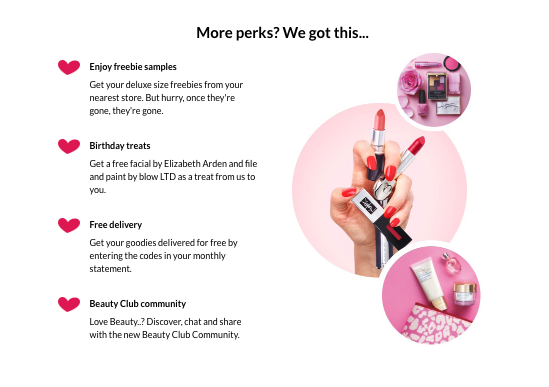
This offers an edge over their competition – other retailers selling similar products at similar prices are fighting to keep return customers.
So basically what you’re saying is:
|
Something that’s very powerful in the age of GDPR, email privacy, and hyper-crowded inboxes.
|
This option is often the most popular choice and the cheapest to implement. Not only does it ensure you cover the cost of your postage on smaller orders, it encourages customers to order more to reach the threshold - increasing your average order value.
Fifty-eight percent of customers add in free items to qualify for free delivery. Footwear company 2BigFeet even found their conversion rate increased by 50% after deciding to offer free shipping on orders over $100.
Gymshark implement this method well, offering free standard delivery on orders over $75.

And free express delivery on orders over $150.

So customers need to spend almost double to reach the threshold for express delivery. Meaning they effectively give two layers of incentives to bump of average order value.
To find your ideal minimum spend amount to qualify for free shipping, it’s recommended that you take your average order amount and set the minimum to around 10-15% higher.
Reserving free shipping for all your wholesale customers as part of any B2B e-commerce strategy you’re running is also an option. These customers will likely be buying in bulk quantities, and therefore regularly finding themselves way above your typical B2C free shipping threshold.
|
Offering free delivery only on certain items is another option. This means that you can reserve free shipping for just your higher margin products, ensuring you don’t end up making a loss on some sales. Or you could offer free delivery on smaller, lightweight, lower cost items that don’t cost much to ship.
Shoe store Office offer free delivery on full priced items only, excluding sale or discounted offers. The offer also excludes low cost items such as shoe care items, ensuring all orders that are shipped for free are high priced items.
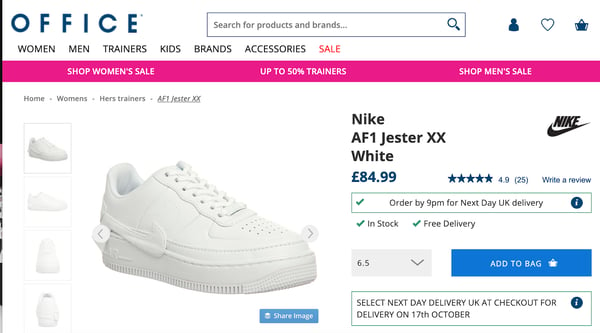

But what you could do is offer these smaller or discounted items as an upsell after someone has checked out. Bulking up order value while ensuring people are ordering your higher margin items.
|
If you’re unsure about the effects that free delivery will have on your business, a good way to test the waters is to offer free delivery as a special offer or during a certain time of year. Or offer free delivery on busy days, like Black Friday or Cyber Monday.
Free shipping can also be used to encourage shoppers to purchase before a certain date, like Valentine's or Mother’s Day. Avon is an example of a company that does this well, offering free shipping on a day that they know their target audience will appreciate.
The brand also communicates this well with appealing graphics on their site, social media accounts and via email.
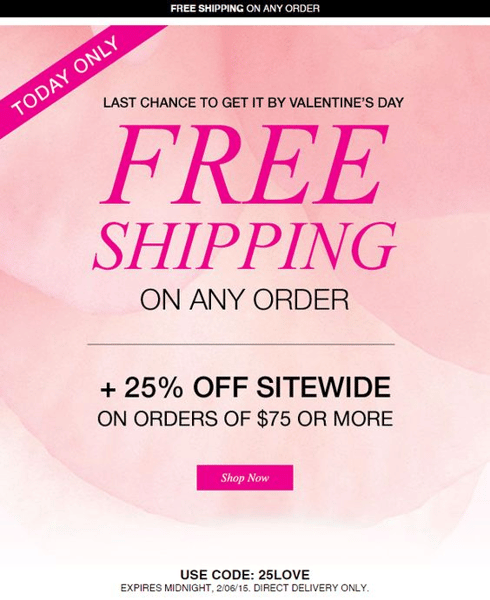
|
6. Free click-and-collect shipping
Many retailers with physical stores are now offering customers free delivery as click-and-collect to their nearest store location. This method has become increasingly popular amongst consumers, and is a great middle ground if you have the infrastructure in place.
Gap utilizes both its own stores, as well as those of Banana Republic.
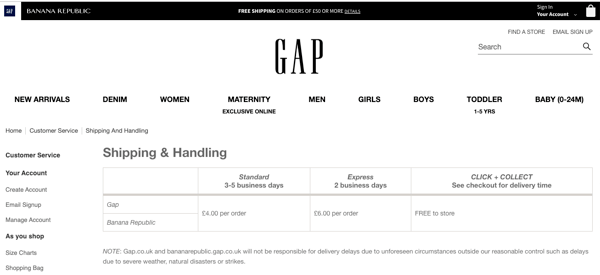
Besides the saved fee, collection from store is appealing to customers as it’s convenient and often faster than shipping. Plus, they don’t have to risk missing a delivery by not being home.
But the best thing about this method is the opportunity to increase how much the customer spends when they come to pick up their order. In fact, eMarketer research found that 85% of customers make additional purchases once in store.
|
Another cost effective way to offer free shipping is to offer your lowest-cost shipping option for free. This is often a slower delivery method, but customers then get the option to pay for faster delivery. Framing your shipping like this can help take the initial ‘sting’ out of a customer seeing shipping costs at checkout, before then upselling them on faster shipping.
Mac Cosmetics offers free standard delivery to customers, which is their slowest delivery option of 2-5 days. But then charge a relatively standard fee for their next shipping option.
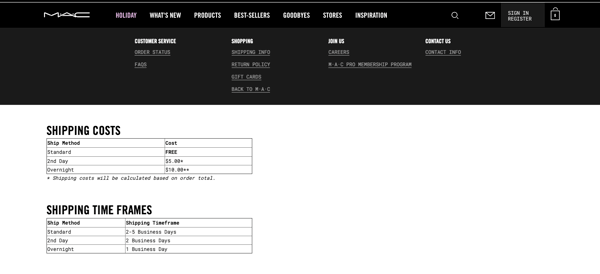
|
Offering free shipping is obviously just not worth it if you can’t make it profitable. So in the pursuit of this, it’s worth looking at some ways to keep your costs to a minimum.
Most shipping companies have pricing structures based on the volume of orders that are shipped, meaning that the more you ship, the less money you pay. A lot of smaller e-commerce businesses don’t negotiate with carriers as they feel they’re not in a position to negotiate. But if you ship a large number of packages, compare prices and try to negotiate a deal. Many carriers will listen if you offer exclusivity or mention moving to a competitor.
To get the best deal on shipping costs, you can use a shipping rate calculator to compare costs across carriers. Shipping rates from large carriers are constantly changing, so keeping track of the options can be difficult. By using a shipping rate comparison tool, you can keep up-to-date with new charges, and always find the best price to ship your parcels.
For many e-commerce retailers, using multiple shipping carriers is necessary to get the best deal. But using multiple carriers is hard work from an organizational point of view, and without a quality shipping software it can be a real pain.
This software will pull all your orders into a single platform where you can ship in one place. By connecting your carriers to the software, you can get automatically calculated rates from multiple carriers and print the labels.
|
TIP: Find available shipping software on the market today on G2. Compare costs and make the best buying decision for your e-commerce business. |
The way you communicate your shipping strategy will have a huge effect on how customers respond. Your customers want to know what to expect when they reach checkout, which will in turn reduce abandoned carts due to unexpected costs.
So you want to shout your shipping policy from the rooftops – especially if it utilizes any of the above free options.
Some ways to communicate this is to:
|
To ensure you’re not running at a loss, it’s important to thoroughly test your chosen strategy. It’s a good idea to run your chosen method as a promotion first. Rather than roll it out as a permanent policy.
Testing your promotion for around four weeks gives you a solid set of data to see whether your offer is attracting the amount of customers you need to make it work. You should then track your results before, during and after the promotion to figure out whether it’s worth implementing as a permanent policy.
But remember, you should be analyzing success from both a sales/customer popularity point of view and a profitability point of view. Good metrics to track here will be average order value, conversion rate and abandoned cart rates as well as your profit/loss for the month.
Free shipping is a fantastic weapon to have in ecommerce. And there are tons of ways to implement a free shipping strategy while staying profitable. But it’s important to test a couple over a shorter period rather than straight out implementing a policy that ends up losing you money.
Study up on the latest e-commerce statistics to stay in the know about other ways to best amplify your e-commerce store, get more sales, and stand out from the competition.
Mike Glover is Content Editor at Veeqo, a platform that handles inventory, orders, and shipping for omnichannel retail brands, allowing them to grow quickly while guaranteeing customers the epic experience they deserve.
Running a business is never easy, and when you're selling wholesale – especially when you're...
 by Jake Rheude
by Jake Rheude
When it comes to the art and magic of branding, few do it better than Disney.
 by Digge Zetterberg Odh
by Digge Zetterberg Odh
The end of the year can be a lucrative time for SaaS companies.
 by Alice Corner
by Alice Corner
Running a business is never easy, and when you're selling wholesale – especially when you're...
 by Jake Rheude
by Jake Rheude
When it comes to the art and magic of branding, few do it better than Disney.
 by Digge Zetterberg Odh
by Digge Zetterberg Odh


